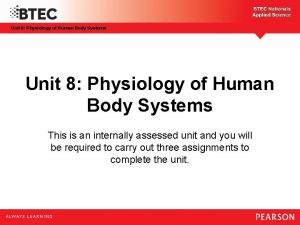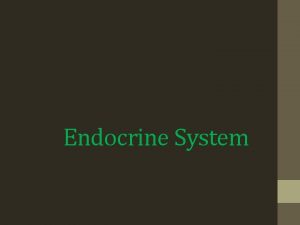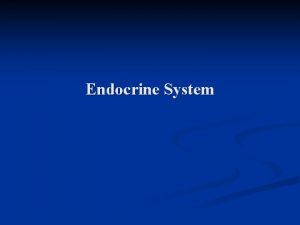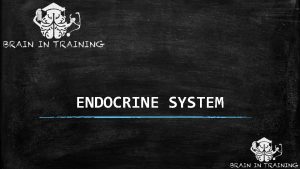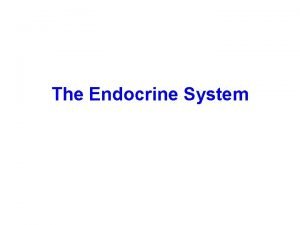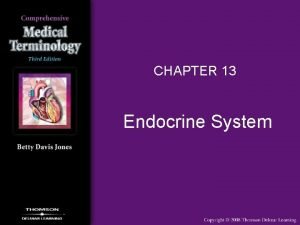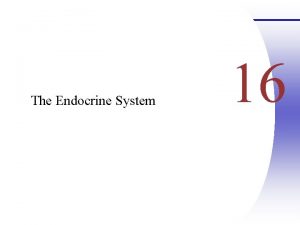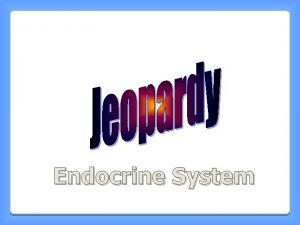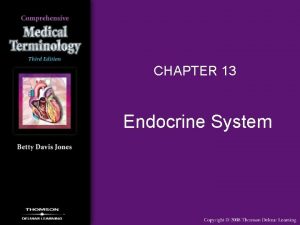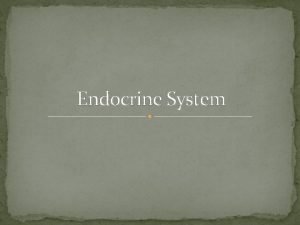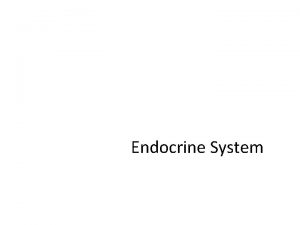Endocrine System HUMAN PHYSIOLOGY Endocrine System Overview Works













- Slides: 13

Endocrine System HUMAN PHYSIOLOGY

Endocrine System: Overview Works with nervous system to coordinate activities Major influence on metabolism Endocrine glands: pituitary, thyroid, parathyroid, adrenal, and pineal glands Endocrinology – study of the endocrine system and its hormones Hormones • Reproduction • Growth and development • Maintenance of water and electrolytes • Cellular metabolism and energy • Initiation of body’s defenses

Chemistry of Hormones Two main classes 1. Amino acid-based hormones ○ Amines, thyroxine, peptides, and proteins 2. Steroids ○ Synthesized from cholesterol ○ Gonadal and adrenocortical hormones

Mechanisms of Hormone Action Two mechanisms, depending on their chemical nature 1. Water-soluble hormones (all amino acid–based hormones except thyroid hormone) 2. Lipid-soluble hormones (steroid and thyroid hormones)

The Pituitary Gland Hypothalamus The pituitary gland (hypophysis) has two major lobes 1. Posterior pituitary (lobe): Pituicytes (glial-like supporting cells) and nerve fibers 2. Anterior pituitary (lobe) (adenohypophysis) Glandular tissue

Anterior Pituitary Hormones Growth hormone (GH) Thyroid-stimulating hormone (TSH) or thyrotropin Adrenocorticotropic hormone (ACTH) Follicle-stimulating hormone (FSH) Luteinizing hormone (LH) Prolactin (PRL)

The Posterior Pituitary Contains axons of hypothalamic neurons Stores antidiuretic hormone (ADH) and oxytocin ADH and oxytocin are released in response to nerve impulses

The Thyroid Gland • Consists of two lateral lobes connected by a median mass called the isthmus • Composed of follicles that produce the glycoprotein thyroglobulin • Parafollicular cells produce the hormone calcitonin

Parathyroid Glands • Four to eight tiny glands embedded in the posterior aspect of the thyroid • Contain oxyphil cells (function unknown) and chief cells that secrete parathyroid hormone (PTH) or parathormone • PTH—most important hormone in Ca 2+ homeostasis

Adrenal (Suprarenal) Glands • Paired, pyramid-shaped organs atop the kidneys • Structurally/functionally, they are two glands in one • Adrenal medulla— nervous tissue; part of the sympathetic nervous system • Adrenal cortex—three layers of glandular tissue that synthesize and secrete corticosteroids

Adrenal Cortex Three layers and the corticosteroids produced Zona glomerulosa— mineralocorticoids Zona fasciculata— glucocorticoids Zona reticularis—sex hormones, or gonadocorticoids

Pineal Gland • Small gland hanging from the roof of the third ventricle • Pinealocytes secrete melatonin, derived from serotonin

Pancreas • Triangular gland behind the stomach • Has both exocrine and endocrine cells Acinar cells (exocrine) produce an enzyme-rich juice for digestion Pancreatic islets (islets of Langerhans) contain endocrine cells Alpha ( ) cells produce glucagon (a hyperglycemic hormone) Beta ( ) cells produce insulin (a hypoglycemic hormone)
 Nrswa revision
Nrswa revision Endocrine system and reproductive system
Endocrine system and reproductive system Endocrine system vs nervous system
Endocrine system vs nervous system Lymphatic system vs endocrine system
Lymphatic system vs endocrine system Nervous system vs endocrine system venn diagram
Nervous system vs endocrine system venn diagram Endocrine system
Endocrine system Endomysium
Endomysium Waistline
Waistline Unit 8 physiology of human body systems assignment 1
Unit 8 physiology of human body systems assignment 1 Anatomy and physiology exam 1
Anatomy and physiology exam 1 Holes essential of human anatomy and physiology
Holes essential of human anatomy and physiology Distal and proximal
Distal and proximal Chapter 2 human reproductive anatomy and physiology
Chapter 2 human reproductive anatomy and physiology Uterus perimetrium
Uterus perimetrium








